VIRUS UPDATE: 29 new positive cases detected in Xàbia, the lowest since early July
The 14-day IA rate in the Marina Alta has more than halved compared to two weeks ago as the so-called ‘fifth wave’ continues to ebb.
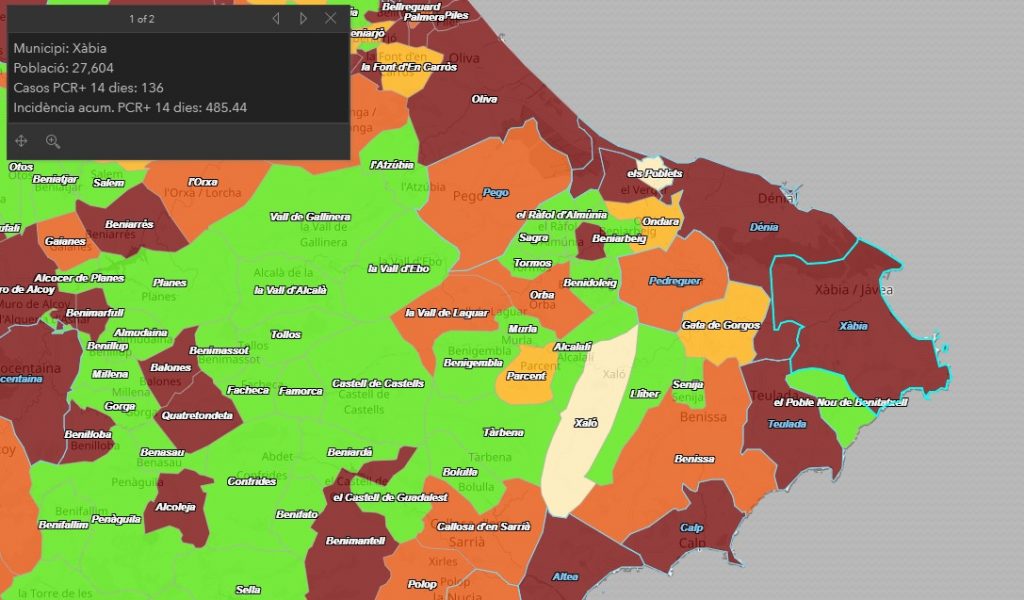
Friday 20th August 2021 – Compiled by MIKE SMITH
Xàbia
The total number of positive coronavirus cases detected by PCR test in Xàbia has climbed to 2,221, according to the latest update from the regional health ministry, a rise of 29 since the last update on Tuesday 17th August.
The municipality’s 14-day IA rate, a measure of the speed at which the virus moves through the population, has dropped to 485.44 cases per 100,000 inhabitants and the town remains in the ‘Extreme Risk’ alert level.
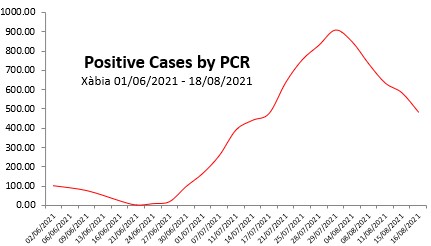
There have been no new deaths in Xàbia since late March and the number remains at 12.
Marina Alta
There have been 583 new positive cases detected by PCR test in the Marina Alta in the past 14 days and the region’s 14-day IA rate has dropped to 341.68 cases per 100,000 inhabitants and it remains in the ‘Extreme Risk’ alert level. The detection of positive cases of COVID-19 in the region has dropped by more than 50% in the past two weeks.
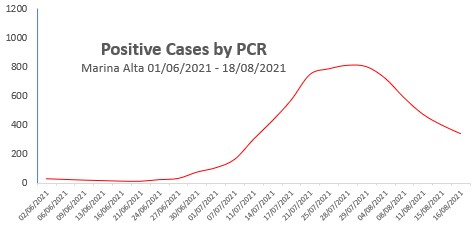
There have been 0 new deaths since the last update and the region’s toll remains at 205.
The total number of positive cases since the pandemic began is now 13,016 since the last update on Tuesday 17th August, a rise of 128.
- 39 – Dénia
- 29 – Xàbia
- 18 – Calp
- 17 – Teulada-Moraira
- 5 – Benissa; El Vergel
- 4 – Pego
- 3 – Ondara
- 2 – Gata de Gorgos; Pedreguer
- 1 – Els Poblets; Orba; Sanet y Negrals; Xaló
Municipalities at EXTREME RISK level
Calp; Dénia; El Vergel; Sanet y Negrals; Teulada-Moraira; Xàbia.
Municipalities at HIGH RISK level
Benissa; Orba; Pedreguer; Pego; la Vall de Laguar.
Municipalities at MEDIUM RISK level
Gata de Gorgos; Ondara; Parcent.
Municipalities at LOW RISK level
Els Poblets; Xaló.
Autonomous Regions at NEW NORMAL level
Adsubia; Alcalalí; Beniarbeig; Benidoleig; Benigembla; Benimeli; Castell de Castells; Llíber; Murla; el Poble Nou de Benitatxell; el Ràfol d’Almúnia; Sagra; Senija; Tormos; la Vall d’Alcala; la Vall d’Ebo; la Vall de Gallinera.
Spain
Spain’s 14-day IA rate is 360.56 cases per 100,000 inhabitants, a drop of more than a quarter in the last week, but the country remains in the ‘Extreme Risk’ category.
The Positivity Rate, the measure of how many coronavirus tests return positive, has dropped to 11.94%. A value of 5% or less indicates that transmission of the virus is more or less under control.
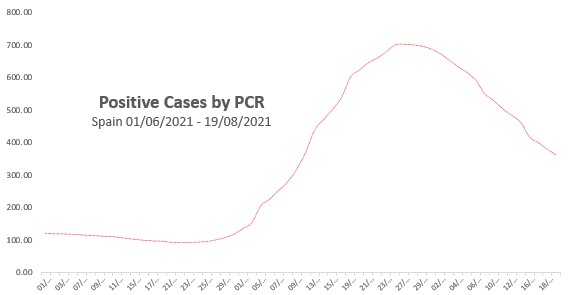
Hospitalizations
According to the latest report from the CCAES, there are 8,507 hospitalized due to COVID-19 across Spain, a drop of almost 52% on two weeks ago, of which 1,847 have been admitted to ICU wards, a drop of 4% on two weeks ago. The percentage of beds in general wards occupied by patients suffering from COVID-19 is 7.26% whilst the percentage of beds in ICU wards occupied by COVID-19 patients is 20.12%.
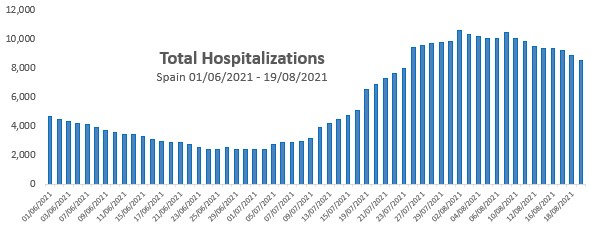
Cataluña still leads the way in hospitalizations, with 1,979 people currently in hospital due to COVID-19, of which 41.49% have been admitted to ICU wards for extreme cases. The autonomous region of Madrid is not far behind, with 1,699 people in hospital, of which 33.09% are in ICU wards, whilst Andalucia has 1,312 people in hospital, 12.36% of which are being cared for in ICU wards.
In the Comunidad Valenciana, 540 people are currently hospitalized, according to the latest CCAES report, with 11.92% of ICU ward capacity occupied by those suffering from the extreme effects of COVID-19.
Deaths
The country has suffered 402 deaths in the past seven days, a rise of almost 24% when compared to two weeks ago. This appears to be the normal progress of the infection spread: positive cases rise, then hospitalizations increase, and finally the number of deaths increase. This can clearly been seen in the three charts given in this summary for Spain.
The national death toll rises to 83,004 since the pandemic began.
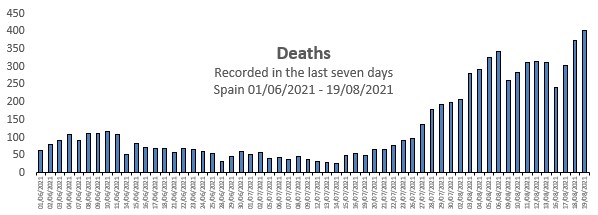
Regional Data
Across Spain, the rise of infections continues to slow all but one of the 19 autonomous regions have reported IA rates lower than they were two weeks ago. The North African enclave of Ceuta (597.37) is the odd one out with a 68% rise in infections in a fortnight but this has been attributed to almost half of the new cases in the last seven days corresponding to outbreaks in migrant reception centres in the city.
Behind Ceuta, six regions remains above 400: Extremadura (474.63), the Baleares (467.25), La Rioja (447.31), País Vasco (445.39), Cantabria (433.00) and Navarra (408.96).
At the other end of the scale, Asturias (187.09) is the first autonomous region to drop below the 200 mark for almost a month.
The Comunidad Valenciana’s rate, currently 295.39, has almost halved in the past two weeks and it remains the autonomous region with the second lowest rate in mainland Spain behind Asturias.
Autonomous Regions at EXTREME RISK level
Andalucia; Aragón; Baleares; Canarias; Cantabria; Castilla y León; Castilla-La Mancha; Cataluña; Ceuta; Comunidad Valenciana; Extremadura; Galicia; La Rioja; Madrid; Melilla; Murcia; Navarra; País Vasco.
Autonomous Regions at HIGH RISK level
Asturias.
Autonomous Regions at MEDIUM RISK level
None
Autonomous Regions at LOW RISK level
None
Autonomous Regions at NEW NORMAL level
None
How does Spain compare to the rest of Europe?
Top 20 table based on new confirmed COVID-19 cases per 1 million population on August 19th 2021.
- Kosovo (772.02) ↑
- Montenegro (706.48) ↑
- United Kingdom (449.51) ↑
- Cyprus (423.26) ↓
- North Macedonia (396.06) ↑
- Republic of Ireland (354.96) ↓
- France (353.27) ↑
- Greece (301.32) ↓
- Iceland (280.48) ↓
- Switzerland (279.14) ↑
- Liechtenstein (265.96) ↑
- Spain (244.80) ↓
- Monaco (236.62) ↓
- Turkey (235.93) ↓
- Portugal (226.63) ↓
- Estonia (207.74) ↓
- Lithuania (199.20) ↑
- Serbia (185.15) ↑
- Denmark (170.16) ↓
- Malta (165.33) ↑
↑ = infection spread rising
↓ = infection spread dropping
Source: ourworldindata.org
Vaccination (19.08.21)
Spain has administered 62,665,513 doses of vaccine, which is 92.9% of those which it has already received (67,461,422). A total of 30,565,129 people have completed the recommended course, which is 72.6% of the total of the population which is to be vaccinated (42,119,827) or 64.4% of the total population of Spain.
According to the latest data provided by the health authorities, 93.6% of people aged 40 and over in Spain have received at least one dose, with 90.6% having completed the recommended course.
The Comunidad Valenciana has administered 6,612,929 doses of vaccine, which is 92.8% of the total which it has received (7,125,800). A total of 3,205,358 people have completed the recommended course, which 71.4% of the population which is to be vaccinated (4,488,459) or 63.4% of the total population of the Comunidad Valenciana.
According to the latest data provided by the health authorities, 94.3% of people aged 40 and over in the Comunidad Valenciana have received at least one dose, with 91.9% having completed the recommended course.
The newspaper El Pais has reported that Spain has more vaccine doses in storage than available recipients, with the country’s regions having an excess of five million shots, almost twice as many as two weeks ago. There are two reasons for this, it says. The first is that Pfizer-BioNTech and Moderna have increased their weekly deliveries to Spain whilst the second is that the number of shots being administered has fallen, thought to be due to August being the holiday season, rather than vaccine rejection. However, according to Oxford University’s ‘Our World in Data’ website, Spain is still a leading country in terms of speed of its vaccination campaign.
How does Spain compare to the rest of Europe?
Top 20 table based on percentage of total population fully vaccinated.
- Malta (92.02%)
- Iceland (74.82%)
- San Marino (69.86%)
- Denmark (67.41%)
- Portugal (66.86%)
- Belgium (66.62%)
- Spain (64.72%)
- Republic of Ireland (63.62%)
- Netherlands (61.47%)
- United Kingdom (60.38%)
- Germany (57.79%)
- Italy (57.65%)
- Hungary (56.96%)
- Austria (56.20%)
- Cyprus (56.03%)
- Luxembourg (55.60%)
- France (53.57%)
- Greece (53.38%)
- Liechtenstein (53.37%)
- Andorra (52.57%)
Source: ourworldindata.org
LINKS
- Actualización nº 444. Enfermedad por el coronavirus (COVID-19). 19.08.2021
- GIV COVID-19 Gestión integral de la vacunación COVID-19
- COVID-19 C. Valenciana: Monitoratge de la situació



